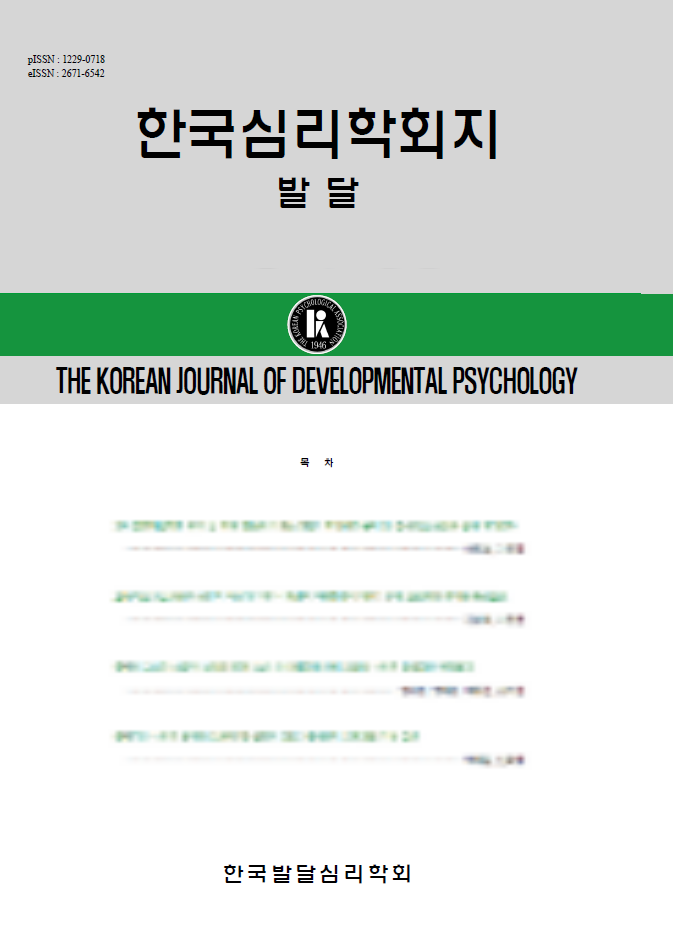open access
메뉴
open access
메뉴 ISSN : 1229-0718
ISSN : 1229-0718

본 연구는 다양한 인종의 얼굴표정에 대한 정서인식이 인종 간에 차이가 있는지를 초등학생 5-6학년 257명과 대학생 120명을 대상으로 알아보았다. 얼굴 정서인식 과제는 기쁨, 슬픔, 화, 공포의 네 가지 표정을 짓고 있는 한국인과 타인종인 동남아인, 백인, 흑인의 남, 여 사진 각각 한 장씩 총 32장의 얼굴표정 사진을 사용하였다. 얼굴 정서인식 과제에 사용한 한국인과 백인, 흑인의 표정사진은 박찬옥과 김혜리(2010)와 Baron-Cohen(2007)의 사진들 중 일부를 사용하였으며, 동남아인의 표정사진은 동남아 영화에서 정서가 잘 표현된 얼굴 장면을 발췌해서 사용하였다. 타인종의 얼굴표정보다 한국인의 얼굴표정에 대해 정서인식을 더 정확하게 하였으며, 타인종 중에서는 백인, 흑인의 얼굴표정보다 동남아인의 얼굴표정에 대해 더 정확하게 판단하였다. 초등학생과 대학생 모두 타인종의 표정자극보다 한국인의 표정자극에 대해 정서인식을 더 정확하게 하였으나, 초등학생과 대학생의 차이는 한국인의 표정자극보다 타인종의 표정자극에서 더 컸다. 이러한 결과는 정서인식능력의 발달적 변화는 동인종보다 타인종 표정자극에서 더 크다는 것을 보여준다.
This study was conducted to test the differences in the recognition of emotional facial expressions of various races. Participants were 257 Korean children in the fifth and sixth grades and 120 undergraduates. Emotional face recognition was measured using 32 pictures of facial expressions (happy, sad, angry, fear) of four different races (Korean, Southeast Asian, Caucasian, African American). There were cross-race differences in emotional face recognition. The facial expressions of Koreans were more accurately recognized than were those of other races, and among other races, the facial expressions of Southeast Asians were more accurately recognized than were those of Caucasian or African Americans. Though the facial expressions of Koreans were more accurately recognized than were those of other races for both age groups, differences were greater among undergraduates than among fifth- and sixth-grade children. The results suggest that the developmental change in emotional face recognition is greater for the facial expressions of other races than for those of Koreans.
박찬옥, 김혜리 (2010). 초등 6학년 아동의 성별과 또래지위에 따른 공감하기 및 체계화하기 차이. 한국심리학회지: 발달, 23(4), 127-148.
양혜영, 김혜리, 김경미, 구재선, 정명숙, 박은혜 (2008). 초등학생의 마음이론과 사회적능력의 관계. 한국심리학회지: 발달, 21(1), 31-47.
이수미, 조경자, 김혜리 (2012). 얼굴표정을 통한 정서읽기 능력의 발달적 변화. 한국심리학회지: 발달, 25(3), 55-72.
조경자, 박수진, 송인혜, 김혜리 (2007). 정서상태와 얼굴표정간의 연결 능력의 발달. 감성과학, 10(1), 127-138.
통계청 (2013). 2012 체류외국인 통계. 출입국외국인 정책 통계연보.
Baron-Cohen, Simon. (2007). Mind Reading: The interactice Guide to emotions. Version 1.3[CD-ROM]. Jessica Kingsley Pub.
Ducci, L., Arcuri, L., W/Georgis, T., & Sineshaw, T. (1982). Emotion recognition in Ethiopia:The effect of familiarity with Western culture on accuracy of recognition. Journal of Cross-Cultural Psychology, 13, 340-351.
Ekman(이민아 옮김) (2006). 얼굴의 심리학: 우리는 어떻게 감정을 느끼는가?, 서울, 바다출판사.
Ekman, P. (1972). Universals and cultural difference in facial expression of emotion. In J. K. Cole (Ed.). Nebraska symposium on motivation, 1971. Lincoln, NE: University Press.
Ekman, P. (1982). Methods for measuring facial action. In K. Scherer & P. Ekman(Eds.), Handbook of methods in nonverbal behavior research. Cambridge University Press.
Ekman, P., & Friesen, W. V. (1976). Pictures of facial affect[Slides]. San Francisco: Department of Psychology, San Francisco State University.
Ekman, P., Friesen, W. V., O'Sullivan, M., Chan, A., Diacoyanni-Tarlatzis, I., Heider, K., et al. (1987). Universals and cultural differences in the judgements of facial expressions of emotion. Journal of Personality and Social Psychology, 53, 712-717.
Ekman, P., Sorensen, E. R., & Friesen, W. V. (1969). Pancultural elements in facial displays of emotions. Science, 164, 86-88.
Elfenbein, H. A., & Ambady, N. (2002). Is there an in-group advantage in emotion recognition? Psychological Bulletin, 128(2), 243-249.
Elfenbein, H. A., & Ambady, N. (2003a). Universals and Cultural differences in Recognizing emotions. American Psychological Society, 12(5), 159-164.
Elfenbein, H. A., & Ambady, N. (2003b). Cultural Similarity's Consequences: A Distance Perspective on cross-cultural Differences in emotion recognition. Journal of Cross-Cultural Psychology, 34, 92-110.
Haviland, J. M., & Lewica, M. (1987). The induced affect response:10 week-old infants'response to three emotional expressions. Developmental Psychology, 23, 97-104.
Izard, C. E. (1971). The face of emotion. New York:Appleton-Century-Crofts.
Izard, C. E., & Malatesta, C. Z. (1987). Perspectives on emotional development: Differential emotions on emotions theory of early development. In J. D. Osofsky(Ed.), Handbook of Infant Development(pp.494-554). New York: Wiley.
Matsumoto D, Ekman P. (1988). Japanese and Caucasian Facial Expressions of Emotion(JACFEE)Sliders. Intercultural and Emotion Research Laboratory, Department of Psychology, State University, San Francisco.
Matsumoto, D. (1989). Cultural influences on the perception of emotion. Journal of Cross-Cultural Psychology, 20, 92-105.
Mehrabien, A. (1972). Nonverbal communication. Chicago: Aldine/ Achecton.
Rosenthal, R., Hall, J. A., Dimatteo, M. R., Rogers, P. L., & Archer, D. (1979). Sensitivity to nonverbal communication: The PONS test. Baltimore: John Hopkins University Press.
Scherer, K. R., Banse, R., & Wallbott, H. (2001). Emotion inferences from vocal expression correlate across languages and cultures. Journal of Cross-Cultural Psychology, 32, 76-92.
Shioiri T, Someya T, Helmeste DM, & Tang SW (1999). Cultural difference in recognition of facial emotional expression: Contrast between Japanese and American raters. Psychiatry and Clinical Neurosciences, 53, 629-633.
Termine, N. T., & Izard, C. E. (1988). Infants'responses to their mothers' expressions of joy and sadness. Developmental Psychology, 24, 223-229.
Wallbott, H. G., & Scherer, K. R. (1988). How universal and specific is emotional experience? Evidence from 27 Countries on five continents. In K. R. Scherer(Ed.), Facets of emotion: Recent research. Hillsdale, NJ: Erlbaum.
Yueqin Huang, Siu Tang, Daiga Helmeste, Toshiki Shioiri, & Toshiyuki Someya (2001). Differential judgement of static facial expressions of emotions in three cultures. Psychiatry and Clinical Neurosciences, 55, 479-483.
